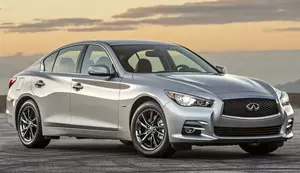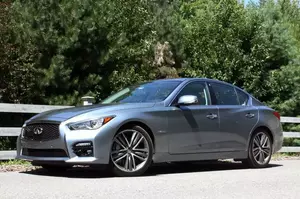
| Vehicle | Curb weight | Difference from world's smallest | Weight to power ratio | 0—60 mph acceleration ratio | Consumption ratio |
|---|---|---|---|---|---|
| 3.5 |
1813 kg / 3998 lbs |
1388 kg (3061 lbs) heavier | 6 kg to 1 hp | 355 kg/s (783 lbs/s) |
275 kg/L (606 lbs/L) |
| 2.2d |
1613 kg / 3557 lbs |
1188 kg (2620 lbs) heavier | 9 kg to 1 hp | 194 kg/s (428 lbs/s) |
358 kg/L (789 lbs/L) |
| 2.0t |
1512 kg / 3334 lbs |
1087 kg (2397 lbs) heavier | 7 kg to 1 hp | 222 kg/s (490 lbs/s) |
240 kg/L (529 lbs/L) |
| S 3.0t |
1724 kg / 3801 lbs |
1299 kg (2864 lbs) heavier | 4 kg to 1 hp | 359 kg/s (792 lbs/s) |
189 kg/L (417 lbs/L) |
| Vehicle | 3.5 |
|---|---|
| Curb weight |
1813 kg / 3998 lbs |
| Difference from world's smallest | 1388 kg (1388 lbs) heavier |
| Weight to power ratio | 6 kg to 1 hp |
| 0—60 mph acceleration ratio | 355 kg/s (783 lbs/s) |
| Consumption ratio |
275 kg/L (606 lbs/L) |
| Vehicle | 2.2d |
| Curb weight |
1613 kg / 3557 lbs |
| Difference from world's smallest | 1188 kg (1188 lbs) heavier |
| Weight to power ratio | 9 kg to 1 hp |
| 0—60 mph acceleration ratio | 194 kg/s (428 lbs/s) |
| Consumption ratio |
358 kg/L (789 lbs/L) |
| Vehicle | 2.0t |
| Curb weight |
1512 kg / 3334 lbs |
| Difference from world's smallest | 1087 kg (1087 lbs) heavier |
| Weight to power ratio | 7 kg to 1 hp |
| 0—60 mph acceleration ratio | 222 kg/s (490 lbs/s) |
| Consumption ratio |
240 kg/L (529 lbs/L) |
| Vehicle | S 3.0t |
| Curb weight |
1724 kg / 3801 lbs |
| Difference from world's smallest | 1299 kg (1299 lbs) heavier |
| Weight to power ratio | 4 kg to 1 hp |
| 0—60 mph acceleration ratio | 359 kg/s (792 lbs/s) |
| Consumption ratio |
189 kg/L (417 lbs/L) |

| Vehicle | Curb weight | Difference from world's smallest | Weight to power ratio | 0—60 mph acceleration ratio | Consumption ratio |
|---|---|---|---|---|---|
| 2.0 |
1510 kg / 3330 lbs |
1085 kg (2393 lbs) heavier | 7 kg to 1 hp | 222 kg/s (490 lbs/s) |
240 kg/L (529 lbs/L) |
| S 3.0 V6 |
1712 kg / 3775 lbs |
1287 kg (2838 lbs) heavier | 4 kg to 1 hp | 357 kg/s (787 lbs/s) |
188 kg/L (415 lbs/L) |
| 2.2D |
1641 kg / 3618 lbs |
1216 kg (2681 lbs) heavier | 10 kg to 1 hp | 203 kg/s (448 lbs/s) |
342 kg/L (754 lbs/L) |
| S 3.5 V6 |
1853 kg / 4086 lbs |
1428 kg (3149 lbs) heavier | 5 kg to 1 hp | 363 kg/s (800 lbs/s) |
273 kg/L (602 lbs/L) |
| Vehicle | 2.0 |
|---|---|
| Curb weight |
1510 kg / 3330 lbs |
| Difference from world's smallest | 1085 kg (1085 lbs) heavier |
| Weight to power ratio | 7 kg to 1 hp |
| 0—60 mph acceleration ratio | 222 kg/s (490 lbs/s) |
| Consumption ratio |
240 kg/L (529 lbs/L) |
| Vehicle | S 3.0 V6 |
| Curb weight |
1712 kg / 3775 lbs |
| Difference from world's smallest | 1287 kg (1287 lbs) heavier |
| Weight to power ratio | 4 kg to 1 hp |
| 0—60 mph acceleration ratio | 357 kg/s (787 lbs/s) |
| Consumption ratio |
188 kg/L (415 lbs/L) |
| Vehicle | 2.2D |
| Curb weight |
1641 kg / 3618 lbs |
| Difference from world's smallest | 1216 kg (1216 lbs) heavier |
| Weight to power ratio | 10 kg to 1 hp |
| 0—60 mph acceleration ratio | 203 kg/s (448 lbs/s) |
| Consumption ratio |
342 kg/L (754 lbs/L) |
| Vehicle | S 3.5 V6 |
| Curb weight |
1853 kg / 4086 lbs |
| Difference from world's smallest | 1428 kg (1428 lbs) heavier |
| Weight to power ratio | 5 kg to 1 hp |
| 0—60 mph acceleration ratio | 363 kg/s (800 lbs/s) |
| Consumption ratio |
273 kg/L (602 lbs/L) |